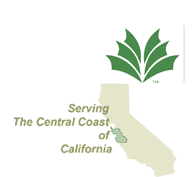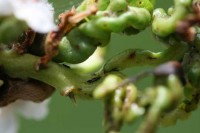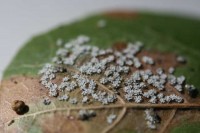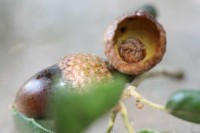New Pests
Myoporum Thrips:
A new invasive insect species is causing severe disfiguration of Myoporum trees. Myoporum thrips are dark brown, insects 2.0 to 2.5 mm in size. These insects feed on leaves of Myoporum trees/shrubs. The damage from this species is characterized by gall-like (abnormal outgrowths) symptoms and curling and disfigurement of the new foliage. The insects maybe seen on the leaves near the growing tips, but are usually found in the curled leaves. Successful treatment and control options are available for your trees.
- First found in southern CA in 2005, Hawaii and the Bay area in 2008
- Native to Australia and New Zealand
- Causes severe galling of leaves
- Effective control strategies have been established
- Important to treat early in life cycle to obtain best results
Whitefly /Aphids:
Whiteflies and Aphids are tiny, sap-sucking insects. Stressed trees are often predisposed to colonization by these insects. They excrete sticky honeydew and cause yellowing or death of leaves. Outbreaks often occur when the natural biological control is disrupted. If treated before large outbreaks occur, nuisance sap and cotton candy like build up can be avoided. Early season applications of systemic pesticide either by trunk or soil injection, will help prevent these outbreaks. Applications of low Nitrogen, complete fertilizer and other site management procedures will reduce plant stress and help with disease and pest resistance.
Drippy acorn disease:
Symptoms of Drippy Acorn Disease are nearly identical to aphid and whitefly outbreaks in that large amounts of sticky substances are emitted in late summer. This condition though a nuisance for those who are affected by it, will not kill a tree. It is caused by a bacterial infection (Brenneria quercina) which is vectored by filbert weevils. Infection causes foamy/sticky substance which drip onto vehicles , patios, decks and landscape features. Though there is no known cure for the disease, canopy sprays to reduce acorn production may be helpful.
Gold spotted oak borer:
First detected in San Diego County in 2004 by the California Department of Agriculture, this borer is causing extensive mortality to oak trees growing in the Cleveland National Forest in Southern California. This pest primarily affects coast live oak, black oak, canyon oak. These are the primary oak species of the Central California coastal mountains. Currently, its distribution is still limited to Southern California, but due to the high tree mortality potential of this pest, and lack of effective control,Government officials are very concerned about its spread northward. The most common form of spread is by firewood transportation. See our notes from the 2009 International Science Symposium on SOD.
Tree Solutions arborists specialize in diagnosis of these and other diseases affecting trees and plants on the Central Coast. Monitoring and proper treatment are essential for control and in some cases the survival of your trees. Contact us to if you need more information and/or think your trees are infested by any of these pest.





